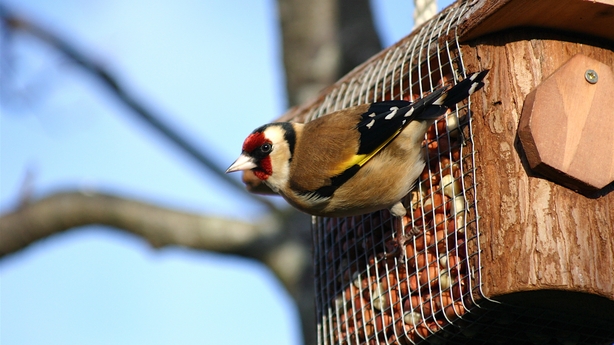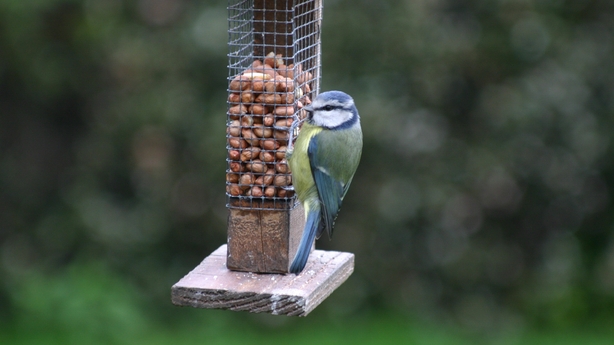The name January originates from the Roman God, Janus, of beginnings and transitions. Janus had two faces, so that he could see into the past and the future. Well, we're going to looking the future to find out more about what Nature we can see this coming month.

We are now in the middle of winter with plenty of dark cold days ahead. With that in mind we should continue to feed the wild birds in the garden. In fact, you will find that as the weather is colder, more birds (and a greater variety) will venture into the garden and feeders. But remember, it's vitally important that once you have started to feed them you must continue as they become dependent on your help. And what a joy to watch these finches and tits from the kitchen.
Sadly, not all birds will make it through the winter and you might come across some dead ones. If you come across a dead bird with a metal BTO ring on its leg, you should report it. This ringing data helps measure trends in bird populations. With care and wearing gloves either take a note of the ring number or remove the ring and pass on the information to https://www.bto.org/our-science/projects/bird-ringing-scheme or post the ring to BTO, The Nunnery, Thetford, Norfolk IP24 2PU)
Because of the cold weather and scarcity of food, other animals may be attracted to the garden, like this red squirrel, our native squirrel happily increasing in numbers again throughout the country.
You might think that there is little plant activity at the moment, but that’s not so. On a walk along the canal all the alder trees are displaying beautiful long dangling male catkins. These dancing structures disperse their pollen which is wind borne.
Another plant in flower at this time of year is the snowdrop. It’s hard to believe that such a delicate flower will survive and actually manage to reproduce. Although they do produce seeds, because of the cold weather, very few insects are about and they reproduce mainly by bulb division. That’s not to say that on a warm winter’s day, you won’t see flying insects visit the flowers. Although most people just enjoy snowdrops in the garden it is possible to bring in some cut flowers to adorn the house.
Winter is a great time to get out for a brisk walk. Blow away those after Christmas blues. Pick your favourite walk and spend an hour or two just enjoying the experience. It could be in your local park, along a river or canal or at the seashore. The North Bull Island is a national nature reserve in Dublin Bay on the Northside of Dublin. A haven for both local and visiting wildlife the area has several nature conservation designations for the habitats and species it supports. Internationally important numbers of waterfowl and wading birds overwinter on the islands salt marshes, tidal lagoons and mudflats. And if you visit, don’t forget to call into the interpretive centre. It’s well worth it.
You might wish to try and seek out a starling murmuration. This is always one of my winter highlights. Check with BirdWatch Ireland for one that may be close to you. Thousands, sometimes hundreds of thousands of birds performing incredible tasks just before they roost for the night. This particular one is from Kilbeggan in Co. Westmeath a couple of years ago, and every "black dot" is a bird. And this was only a small section of the whole murmuration!
If its a more leisurely walk you decide on, why not check out the local lichen population. Lichens are everywhere and they are beautiful. Better still, they are easily photographed, especially with smart phones. If you are looking for a good book to help identify them, then it has to be "Lichens of Ireland" by Paul Whelan. It’s my go to guide every time.
With little foliage on the trees and the cold weather enticing more birds into the garden, keep an eye out for some that you might not be all too familiar with. The wren is Ireland’s second smallest bird, found skulking in the undergrowth. You won’t see him at the bird feeder, but if you keep your eyes peeled in the undergrowth, there’s a great chance that you will spot him or her. The wren has been at number 10 in the Irish Garden Bird Survey for the last few years. A small brown bird with an upward pointing tail he can be seen darting across the garden.
"The wran, the wran, King of all birds,
On St. Stephen’s day was caught in the furze,
Although he is little, his family is great,
Stand up oul’ lady and give us a treat"
The wren is the King of all birds. But because he was cunning and cheated in the race to discover, he was banned to the undergrowth and his Latin name Trogladytes refers to his habitat - cave dweller.

Another bird you might come cross in the garden is the pied wagtail, or as we call them in Dubai, "Willy Wagtails". It’s called the willy wagtail because it is easily recognised by the bobbing motion of its tail. This bird is the emblem on the Dublin Naturalists Field Club and they were a common sight as they roosted in trees in Dublin’s O’Connell Street.
And finally, if you are out for a walk on a clear, crisp January afternoon, do look up at the sky. It’s at this time of year that magical sky scenes can be see, just like this one.
